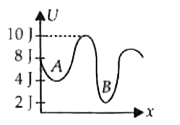A particle moving on x - axis has potential energy U=2−20x+5x2 joule along x - axis. The particle is relesed at x=−3. The maximum value of x will be (x is in metre)
5m
3m
7m
8m
The correct Answer is:C
U=2−20x+5x2
F=−dUdx=20−10x
At equilibrium position , F=0
20−10x=0
⇒x=2
Since particle is released at x=-3, therefore amplitude of particle is 5.

It will oscillate about x=2 with an amplitude of 5.
∴ maximum value of x will be 7.
Topper's Solved these Questions
Similar Questions
The potential energy U of a particle oscillating along x-axis is given as U=10−20x+5x2. If it is released at x=−2, then maximum value of x is
View SolutionA particle can move along x axis under influence of a conservative force. The potential energy of the particle is given by U=5x2–20x+2 joule where x is co-ordinate of the particle expressed in meter. The particle is released at x = –3 m (a) Find the maximum kinetic energy of the particle during subsequent motion. (b) Find the maximum x co-ordinate of the particle.
View Solution
Knowledge Check
- Question 1 - Select One
A particle free to move along the X−axis has potential energy given by U(X)=k[1−exp(−X2)] of appropriate dimensions. Then-
Aat point away from the origin, the particle is in unstable equilibriumBfor any finite nonzero value of X, there is a force directed away from the originCit its total mechanical energy is k/2, it has its minimum kinetic energy at the originDfor small displacement from X=0, the motion is simple harmonic - Question 2 - Select One
A particle of mass 2 kg moving along x-axis has potential energy given by, U=16x2−32x ( in joule), where x is in metre. Its speed when passing through x=1is2ms−1
Athe motion of particle is a uniformly acceleration motionBthe motion of particle is an oscillatory from x=1.5m→3.0mCthe motion of particle is not a simple harmonic motionDthe motion of oscillatory motion is π/2 s - Question 3 - Select One
A particle moves along the X-axis as x=u(t−2s)=at(t−2)2.
Ahave a displacement of 50 mBcover a distance of 40 m in reaching the groundCreach the ground in 4sDbegin to move down after being released
Position of particle moving along x-axis is given as x=2+5t+7t2 then calculate :
View SolutionThe displacement of a particle moving along x-axis is given by :
x=a+bt+ct2
The acceleration of the particle is.View SolutionA particle moves along x-axis whose potential energy versus x-coordinate graph is shown in the given figure. At x = 0, the particle is released form rest. Two potential wells A and B are shown in the figure. Then,
 View Solution
View SolutionA particle is moving along the x-axis with an acceleration a = 2x where a is in ms–2andx is in metre. If the particle starts from rest at x=1 m, find its velocity when it reaches the position x = 3.
View SolutionVelocity of particle moving along x-axis is given as v=(x3−x2+2) m/sec. Find the acceleration of particle at x=2 meter.
View Solution

